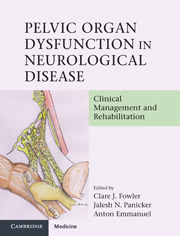18 results
Chapter 19 - Management of Neurogenic Bowel Dysfunction
-
-
- Book:
- Neurorehabilitation Therapy and Therapeutics
- Published online:
- 13 October 2018
- Print publication:
- 11 October 2018, pp 218-223
-
- Chapter
- Export citation
Repeated postoperative follow-up diffusion-weighted Magnetic Resonance Imaging to detect residual cholesteatoma: Presenting Author: Emmanuel Mylanus
-
- Journal:
- The Journal of Laryngology & Otology / Volume 130 / Issue S3 / May 2016
- Published online by Cambridge University Press:
- 03 June 2016, p. S94
- Print publication:
- May 2016
-
- Article
-
- You have access
- HTML
- Export citation
Contents
-
- Book:
- Pelvic Organ Dysfunction in Neurological Disease
- Published online:
- 06 December 2010
- Print publication:
- 04 November 2010, pp v-vi
-
- Chapter
- Export citation
Appendix 1: - Management algorithms
-
- Book:
- Pelvic Organ Dysfunction in Neurological Disease
- Published online:
- 06 December 2010
- Print publication:
- 04 November 2010, pp 307-311
-
- Chapter
- Export citation
Contributors
-
-
- Book:
- Pelvic Organ Dysfunction in Neurological Disease
- Published online:
- 06 December 2010
- Print publication:
- 04 November 2010, pp vii-x
-
- Chapter
- Export citation
Pelvic Organ Dysfunction in Neurological Disease - Half title page
-
- Book:
- Pelvic Organ Dysfunction in Neurological Disease
- Published online:
- 06 December 2010
- Print publication:
- 04 November 2010, pp i-ii
-
- Chapter
- Export citation
Chapter 9 - Neurogenic bowel management
- from Section 2 - Evaluation and management
-
-
- Book:
- Pelvic Organ Dysfunction in Neurological Disease
- Published online:
- 06 December 2010
- Print publication:
- 04 November 2010, pp 138-152
-
- Chapter
- Export citation
Section 3 - Specific conditions
-
- Book:
- Pelvic Organ Dysfunction in Neurological Disease
- Published online:
- 06 December 2010
- Print publication:
- 04 November 2010, pp 167-306
-
- Chapter
- Export citation
Copyright page
-
- Book:
- Pelvic Organ Dysfunction in Neurological Disease
- Published online:
- 06 December 2010
- Print publication:
- 04 November 2010, pp iv-iv
-
- Chapter
- Export citation
Appendix 2: - Surveys and questionnaires
-
- Book:
- Pelvic Organ Dysfunction in Neurological Disease
- Published online:
- 06 December 2010
- Print publication:
- 04 November 2010, pp 312-325
-
- Chapter
- Export citation
Section 1 - Neurological control of pelvic organ functions
-
- Book:
- Pelvic Organ Dysfunction in Neurological Disease
- Published online:
- 06 December 2010
- Print publication:
- 04 November 2010, pp 1-60
-
- Chapter
- Export citation
Pelvic Organ Dysfunction in Neurological Disease - Title page
-
-
- Book:
- Pelvic Organ Dysfunction in Neurological Disease
- Published online:
- 06 December 2010
- Print publication:
- 04 November 2010, pp iii-iii
-
- Chapter
- Export citation

Pelvic Organ Dysfunction in Neurological Disease
- Clinical Management and Rehabilitation
-
- Published online:
- 06 December 2010
- Print publication:
- 04 November 2010
Index
-
- Book:
- Pelvic Organ Dysfunction in Neurological Disease
- Published online:
- 06 December 2010
- Print publication:
- 04 November 2010, pp 326-349
-
- Chapter
- Export citation
Preface
-
- Book:
- Pelvic Organ Dysfunction in Neurological Disease
- Published online:
- 06 December 2010
- Print publication:
- 04 November 2010, pp xiii-xiv
-
- Chapter
- Export citation
Section 2 - Evaluation and management
-
- Book:
- Pelvic Organ Dysfunction in Neurological Disease
- Published online:
- 06 December 2010
- Print publication:
- 04 November 2010, pp 61-166
-
- Chapter
- Export citation
Contributors
-
-
- Book:
- The Cambridge Dictionary of Christianity
- Published online:
- 05 August 2012
- Print publication:
- 20 September 2010, pp xi-xliv
-
- Chapter
- Export citation
Vulnerable patients, vulnerable doctors (CR101)
-
- Journal:
- Psychiatric Bulletin / Volume 27 / Issue 5 / May 2003
- Published online by Cambridge University Press:
- 02 January 2018, p. 195
- Print publication:
- May 2003
-
- Article
-
- You have access
- Open access
- HTML
- Export citation



